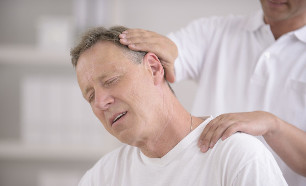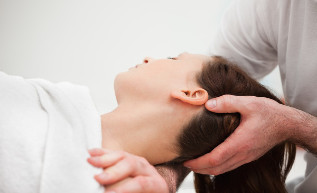
The cervical spine is the narrowest part of it. However, the daily burden of supporting the head, ensuring its rotations and the mobility of the shoulder joints is incomparably higher than the performance of other parts of it.Given the wrong lifestyle caused by eating habits, sedentary work, and smoking, the likelihood of developing cervical osteochondrosis in middle-aged people quadruples.
Despite such a prevalence of the disease, it is very difficult to identify early-stage cervical osteochondrosis because its symptoms are so diverse and at first glance nothing to do with the problem of the spine that a person may not be for yearsDoctor goes, as the reason for their poor health is completelydisease.
Causes of the disease
To ensure the mobility of the vertebrae, intervertebral discs made of cartilage tissue are located between them. They cushion during movement and give the spine flexibility. The inherent lifespan of intervertebral discs is more than 120 years. However, changes in the chemical composition of the blood lead to rapid dehydration of the cartilage tissue, to the deposition of salts, which in turn contributes to the rapid wear of the intervertebral discs and leads to their degenerative-dystrophic changes.
The reason for the change in the composition of the blood is improper nutrition, a sedentary lifestyle in which the cells of the body do not need such an amount of salt and which is deposited in bone tissue, liver and kidneys.In a forced sedentary lifestyle, the greatest amount of salt is deposited on the neck.
Cervical osteochondrosis can also occur due to microtraumas caused by vibrations, e. g. B. with chauffeurs, as well as by the forced wrong position of the head or by tension in the neck caused by the working conditions and the specifics of the job.
What is the risk of cervical osteochondrosis?
In the neck area, namely in the immediate vicinity of the cervical spine, there are nerve roots and the vertebral artery, whose task it is to supply the brain with oxygen. With dehydration of the intervertebral discs of the neck, their deformation occurs, which narrows the gap between the vertebrae and leads to their injury during movement.In addition, the deposition of salts promotes the formation of bone spines - osteophytes, which can injure both the nerve roots and the artery.
The disease leads to a violation of the sensitivity of the neck, shoulder blade, limbs, neck or, on the contrary, causes pain in these areas, depending on which nerve roots have been pinched.
The compression of the vertebral artery is fraught with insufficient oxygen supply to the brain, which leads to the development of various disorders of its activity. The most dangerous consequences of brain hypoxia include hearing impairment, visual impairment, stroke, partial and total paralysis, and mental disorders.
Cervical osteochondrosis is the most dangerous form of the disease as it has many irreversible consequences, while people in the late stages of the disease usually seek help.
Symptoms
The cervical spine consists of 6 segments through which various nerve roots run. Your injury is expressed through various symptoms. Depending on which cervical vertebrae are prone to osteochondrosis, the disease can manifest itself in different symptoms. The radicular syndrome is characterized by the following symptoms:
- Sensory impairment of the neck, the shoulder blade, the fingertips, mostly on one side. Sharp pain in the neck radiating to the back or the back of the head.
- Burning pain in the chest, the shoulder and also one of the fingers, depending on which nerve is affected.
- Pain in the heart area, characterized by its duration and intensification with sudden movements.
The compression of an artery and small vessels can lead to cerebral disorders, the symptoms of which can be listed as follows:
- Visual impairment, the appearance of "flies" in front of the eyes, blurred images.
- With inadequate nutrition of the cerebellum, dizziness, nausea and impaired consciousness, the ground can disappear from under your feet.
- When the blood supply to the brain is disrupted, there is a risk of hypoxia and the body will respond by increasing the pressure needed to increase blood flow.
- Lack of oxygen also leads to a strong unreasonable fear of nausea.
- Possible impairment of coordination and hearing.
- When the lymphatic circulation is impaired, intracranial pressure occurs, which manifests itself in headache of the parietal and occipital parts, pressure on the eyeballs and tinnitus.

Such different symptoms and different individual manifestations of the disease often do not immediately indicate back problems, especially since pain and stiffness of movements may be absent in the early stages. And only a good specialist, having performed differential diagnosis, with the exception of other diseases characterized by the same symptoms, can identify cervical osteochondrosis.
Treatment
Treatment of osteochondrosis is quite a long process and includes various methods of traditional and folk medicine. The main tasks of the doctor when choosing therapy are pain relief, restoration of the mobility of the vertebrae and metabolic processes, recharge of cartilage tissue, as well as the elimination of swelling and inflammation in the soft tissues of the neck. The methods by which the goals described above are achieved are different, including taking medication, rubbing with ointments, physical therapy and special gymnastics. As an additional treatment, recipes for hirudotherapy, acupuncture and traditional medicine are used.
The main component in the treatment of cervical osteochondrosis is the patient's initiative and strict adherence to medical prescriptions.
Let's take a closer look at the treatment of cervical osteochondrosis, as well as the characteristics of the techniques:
drugs
Distinguish between the treatment of osteochondrosis of the cervical spine during exacerbation and remission. For acute pain, the doctor may prescribe:
- Analgesicsin the form of tablets, injections, the task of which is to relieve the symptoms of acute pain.
- Nonsteroidal anti-inflammatory drugsin the form of injections that relieve the inflammatory process. However, the side effects associated with using NSAIDs do not allow them to be used for long periods of time.
- Muscle relaxantsrelieve muscle cramps and loosen pinched vessels, nerves and arteries.
- Novocaine blockade.This method is used in an acute attack accompanied by stiff neck and pain. The treatment takes place under medical supervision.
During the remission period, the main treatment is the ingestion of chondroprotectors, which are made in the form of powders and capsules, suspensions and ointments. Chondroprotectors, based on glycosaminoglycans and chondroitin sulfates, have a number of beneficial effects on the cartilage tissue of the spine, namely the restoration of the nucleus pulposus of the intervertebral disc, the elimination of the pain syndrome and the termination of the development of the disease.
Ointments for osteochondrosis of the cervical spine are prescribed at the discretion of the doctor and have several effects, including:
- painkillers;
- restoration of the cartilage structure;
- anti-inflammatory;
- warming;
- complex.
In addition, cervical osteochondrosis is characterized by compression of the nerve roots and arteries, which leads to a number of symptoms to eliminate, which appropriate drugs are prescribed.
Physiotherapy
In addition to the main treatment, physiotherapeutic procedures are prescribed, the aim of which is to get rid of pain, improve microcirculation in soft tissues, and restore metabolic processes. Some procedures, for example, electrophoresis, are used in conjunction with medicinal ointments, while getting the maximum effect of the drug.
In addition to electrophoresis, shock wave therapy, laser treatment, ultraviolet radiation and magnetotherapy are also used.
A similar effect is achieved with manual massage or acupuncture. A prerequisite for such treatment is a high level of qualification and medical training from specialists in these areas.
Cervical osteochondrosis in remission can be treated with physiotherapy exercises. Properly selected exercises eliminate symptoms of pain and help eliminate salt deposits.
Folk Remedies
Among the methods of treating osteochondrosis of the cervical spine recognized by official medicine, there are many folk recipes based on the healing properties of plants, which have anti-inflammatory, warming and restorative metabolic processes.
The most common active ingredients in different interpretations are horseradish, Adam's root, aloe, ginger, garlic, hops, pine nuts, honey and lemon. They are used in the manufacture of rubs, ointments, tinctures, compresses, mixtures for ingestion, as well as medicinal baths. Traditional methods perfectly relieve symptoms, and also restore neck mobility.



























